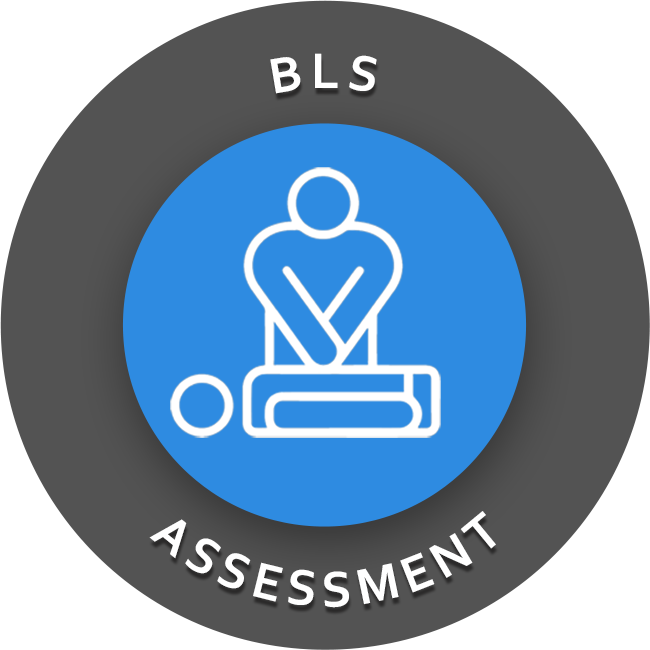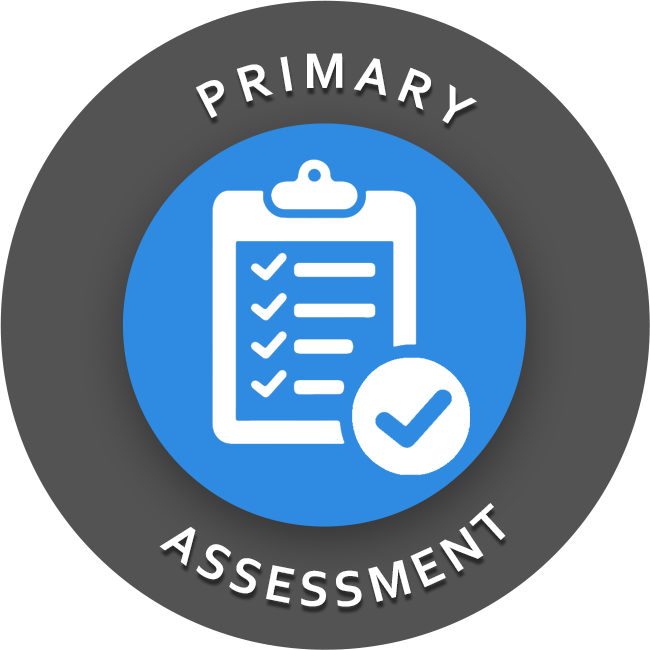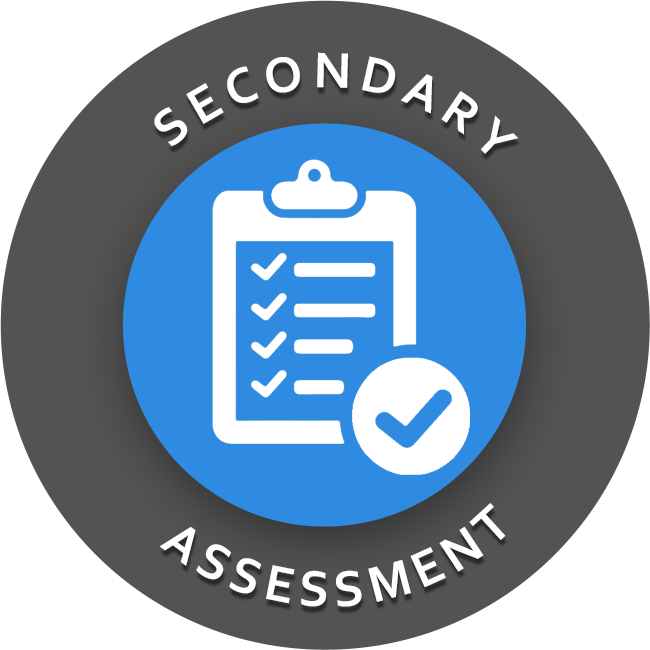
BLS Assessment
Foundational to every ACLS Algorithm is the BLS Assessment. The BLS Assessment is the first step that you will take when treating any emergency situation, and there are 4 main assessment steps to remember.
This is an outline of the 4 steps in the BLS Assessment :
(1) Check responsiveness by tapping and shouting, “Are you all right?” Scan the patient for absent or abnormal breathing (scan 5-10 seconds).
(2) Activate the emergency response system and obtain a AED. If there is more than one rescuer, have the second person activate emergency response and get the AED/Defibrillator.
(3) Circulation: Check for a carotid pulse. This pulse check should not take more than 5-10 seconds. If no pulse is palpable begin CPR.
(4) Defibrillation: If there is no pulse, check for a shockable rhythm with the AED or defibrillator as soon as it arrives. Follow the instructions provided by the AED or begin ACLS Protocol.
For a more in-depth review of BLS refer to the American Heart Association’s BLS Provider Manual.
Remember to assess first then perform appropriate actions, and after each action…reassess.

Primary Assessment for ACLS
The Primary Assessment uses the ABCDE model to systematize the assessment process. The ABCDE’s of the Primary Assessment are:
(A) Airway: Maintain airway and use advanced airway if needed. Ensure confirmation of placement of an advanced airway and secure the advanced airway device.
(B) Breathing: Give bag-mask ventilation, provide supplemental oxygen, and avoid excessive ventilation. Also, adequacy of ventilation and oxygenation should be monitored during this step.
(C) Circulation: Obtain IV access, attach ECG leads, identify and monitor arrhythmias, giving fluids if needed, and use defibrillation if appropriate.
(D) Disability: Perform a general neurological assessment which should include assessment of responsiveness, level of consciousness, and pupil reflex. AVPU acronym may help. (Alert, Voice, Painful, Unresponsive)
(E)Exposure: Ensure that clothing is removed so that a complete visual assessment can be performed. This visual assessment should include looking for signs of trauma, bleeding, burns, or medical alert bracelets.
The Primary Assessment is included in every ACLS algorithm and like the BLS Assessment, it helps to systematize the resuscitation process and improve patient outcomes.

Secondary Assessment for ACLS
The secondary assessment includes a search for underlying causes for the emergency and if possible a focused medical history. This search for for underlying causes, also known as differential diagnosis, requires a review of all of the H’s and T’s of ACLS. Visit H’s and T’s page for a full review.
Performing the focused medical history can be simplified using the acronym SAMPLE. (S)Signs and symptoms; (A)Allergies; (M)Medications; (P)Past Illnesses; (L)Last Oral Intake; (E)Events Leading Up To Present Illness.
Use the links to the left for further details of ACLS Protocol and specific interventions in each ACLS algorithm.
The objective of the review of these ACLS Algorithms is to help prepare you for the ACLS written test and the ACLS Megacode. After reviewing, you can test your skills and knowledge by accessing the ACLS Megacode Simulator and ACLS practice exams.
Rick Raub says
Technically, Isn’t a pulseless VT ( that we shock) also a PEA, pulseless electrical activity, that we don’t shock? I know we shock one and not the other, but it seems they both are PEA’s.
Jeff with admin. says
Technically, pulseless VT could be classified as PEA however, it is the only “PEA” rhythm that is treated differently that other organized pulseless rhythms.
Kind regards,
Jeff
Carolyn says
I am new to ACLS. My test is on Monday. I think I know the answer to this, but I just wanted a second opinion first. Say I am driving someone to the hospital for chest pain, but he becomes unresponsive before we get there. Do I keep driving to get him to the hospital as soon as possible, or do I pull over, call 911, check for a pulse, and do CPR on the side of the road until the ambulance comes? Granted, I realize I would need to assess the location to make sure it would be a safe enough place to do CPR, but if it is, I would think the 2nd option to be the patient’s best chance, since the chain of survival clearly illustrates early CPR as an essential step. Thank you for your time and your very helpful website.
Jeff with admin. says
Your best option in this situation would be to pull over call 911 and and then begin CPR. So yes, you are correct.
Kind regards, Jeff
Christopher says
This question may be to specific, but I’ve never found a direct answer. If you encounter a SCA by yourself; not in yelling or paging distance of anyone else: Are you supposed to just do CPR or go get AED/Crash cart. Which choice would be most successful?
Jeff with admin. says
It depends. If the arrest was witnessed and you have determined patient is pulseless, you would activate EMS and then promptly return and begin CPR.
If the arrest was unwitnessed and you have determined that the patient is pulseless, then you would give 5 cycles of CPR and then activate EMS.
Kind regards,
Jeff
tcrowther says
I passed my class today! I studied the AHA book, but with the help of this site, I understand and can apply what I’ve learned! passed ACLS today…Thanks for the help! Great site.
svdel says
Hi Jeff, this will be my first ACLS class to take. I’m so glad to find your site as a source. I’m learning a lot. Anyways, would you please explain the difference between the defibrillation and the cardioversion. thanks
Jeff with admin. says
Thank you for the feedback. Here is a webpage on the site that will explain the difference between synchronized and unsynchronized cardioversion: https://acls-algorithms.com/synchronized-and-unsynchronized-cardioversion
Gustavo says
Are the 2010 guidelines the newest one?
Jeff with admin. says
Yes, the 2010 AHA ACLS guidelines are good from 2010 through 2015. In 2015, AHA will have a conference and revise the guidelines if necessary. AHA meets every 5 years to do this.
Kind regards,
Jeff
Barry says
I noticed on one of the videos that talked about chest compressions for the adult gave the distance of 2-2 1/2 inches. I thought the depth was 2 inches for the adult.
Jeff with admin. says
The new guidelines say “at least 2 inches.” The old guidelines stated 1 ½ to 2 inches.
Kind regards,
Jeff
mohaneje3 says
I thought the BLS survey have changed from ABC to CAB. However ACLS survey is based on BLS survey, would that order change as well.
Jeff with admin. says
The sequence of CPR being CAB from ABC is different than the steps for the BLS Survey and The ACLS Survey. The page that you commented on was regarding the BLS Survey and the ACLS Survey. This information can be found on page 12-16 in the AHA ACLS provider manual.
Kind regards,
Jeff
gina1 says
i wish i can read the rationale right away instead of referring me to the page number in the manual. that’s my only comment, otherwise this is a great tool for passing the ACLS. i take the test tomorrow. wish me luck!
Praba says
Dr.Jeff,
can you explain me the difference between monophasic & biphasic defibrillator
Jeff with admin. says
Monophasic uses direct current which passes in one direction from one paddle to the next. Biphasic defibrillation, alternates the direction of the pulses and requires less energy for the same effect.
Most biphasic defibrillators have a first shock success rate that is significantly higher than monophasic defibrillators. Roughly 20% higher success with biphasic. Here is a study
Biphasic defibrillation significantly decreases the energy level necessary for successful defibrillation, decreasing the risk of burns and myocardial damage.
Kind regards,
Jeff
Joan.omalley@sbcglobal.net says
Why isn’t “Perform CPR if needed” listed as one of the directions under the (C) Circulation section of the ACLS Survey?
Jeff with admin. says
“Perform CPR if needed” would be one of the initial steps that is used in the BLS Survey. It is included in Step 3. Please see page 13 of the AHA ACLS Provider Manual.
Kind regards,
Jeff
jak says
Why we are not treating PEA or Asystole same as that management of VF and Pulseless VT, ie why defibrillation is not recomended for Asystole and PEA?
Jeff with admin. says
With VT and VF there is electrical activity that is not coordinated. Defibrillation is used with VT and VF to stun the heart and reset the electrical system of the heart. The goal of defibrillation. Is to re-establish effective coordination between the atria and the ventricles.
Defibrillation is not effective PEA and Asystole. With PEA and Asystole there is no electrical activity that is being transmitted or producing some type of muscular response. Thus, stunning the heart (defibrillation) would not reset an already non-functional electrical system.
The only effective treatment for PEA and Asystole is the use of CPR and the use of vasopressors. Also identifying and treating underlying causes (h and t) is important.
Kind regards,
Jeff
ptrimble says
Or as we say….”you can’t shock an already dead heart”. 🙂
Debbie1 says
I love this site. I will pass it on to my co workers.
Thanks Deb
planewilliams says
A-B-C is now C-A-B according to the 2010 guidelines. Will your information be adjusted to reflect these changes?
Jeff with admin. says
The sequence of CPR being CAB from ABC is different than the steps for the BLS Survey and The ACLS Survey. The page that you commented on was regarding the BLS Survey and the ACLS Survey. This information can be found on page 12-16 in the AHA ACLS provider manual.
Kind regards,
Jeff
david.bonilla says
Wonderful well designed on line course…I have no doubt I will be successful when taking my ACLS examination.